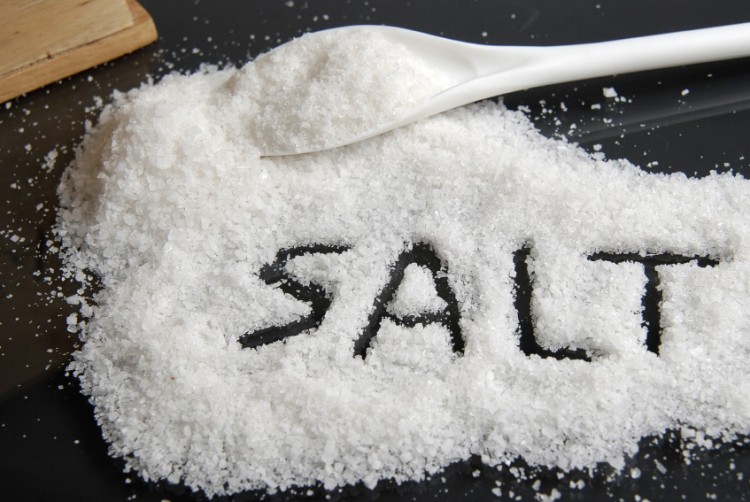Unveiling 6 Supernatural Secrets of Salt
 Throughout history, this humble mineral has been shrouded in mystery and revered for its mystical properties. From ancient rituals to modern-day practices, salt has played a crucial role in protecting, purifying, and healing. Its supernatural secrets span cultures and epochs, transcending the mundane to touch the spiritual. Join us as we delve into the enigmatic world of salt, exploring how this simple substance has been harnessed to ward off evil, cleanse auras, heal the body and soul, and attract prosperity. Discover the captivating power of salt and how it continues to influence spiritual practices around the globe.
Throughout history, this humble mineral has been shrouded in mystery and revered for its mystical properties. From ancient rituals to modern-day practices, salt has played a crucial role in protecting, purifying, and healing. Its supernatural secrets span cultures and epochs, transcending the mundane to touch the spiritual. Join us as we delve into the enigmatic world of salt, exploring how this simple substance has been harnessed to ward off evil, cleanse auras, heal the body and soul, and attract prosperity. Discover the captivating power of salt and how it continues to influence spiritual practices around the globe.
The Protective Powers of Salt
One of the most widespread beliefs about salt is its ability to protect against evil and negative energies. This belief has deep roots in various cultures and traditions, where salt is used to create protective barriers. The practice of sprinkling salt across doorways and windowsills is intended to prevent malevolent spirits and negative energies from entering a home. This tradition is founded on the idea that salt, as a pure and incorruptible substance, has the inherent power to repel impurities and evil forces.
Salt’s protective qualities have been acknowledged in numerous ancient cultures. For example, in ancient Egypt, salt was used in burial rituals to purify and protect the dead in the afterlife. Similarly, in ancient Rome, salt was sprinkled in corners of homes and temples to keep evil spirits at bay. These practices highlight the longstanding belief in salt’s supernatural ability to create a barrier against negative influences.
In European folklore, the protective power of salt is particularly prominent. It was believed that witches and evil spirits could not cross a line of salt. This belief led to the widespread practice of circling one’s home or personal space with salt to ensure safety and peace. This protective circle, often referred to as a “salt ring,” is still used in modern witchcraft and pagan rituals to create a sacred and secure space.
Practical Application: Salt Lines and Circles Sprinkling
 Salt at the thresholds of doors and windows is a simple yet potent method to protect one’s home. The idea is to form an invisible barrier that repels negative energies and entities. This practice can be particularly effective during periods of heightened spiritual activity, such as during a full moon or when moving into a new home. In contemporary witchcraft and Wicca, salt remains a cornerstone of protective magic. Practitioners often use salt in various forms to safeguard their homes and themselves. A common ritual involves mixing salt with water and using this mixture to cleanse and consecrate a space, an object, or a person. This ritual not only purifies but also sets up a protective shield that wards off unwanted energies.
Salt at the thresholds of doors and windows is a simple yet potent method to protect one’s home. The idea is to form an invisible barrier that repels negative energies and entities. This practice can be particularly effective during periods of heightened spiritual activity, such as during a full moon or when moving into a new home. In contemporary witchcraft and Wicca, salt remains a cornerstone of protective magic. Practitioners often use salt in various forms to safeguard their homes and themselves. A common ritual involves mixing salt with water and using this mixture to cleanse and consecrate a space, an object, or a person. This ritual not only purifies but also sets up a protective shield that wards off unwanted energies. 
In religious contexts, salt is often blessed and used as a sacramental element. In the Roman Catholic tradition, exorcism rites involve the use of holy water mixed with blessed salt. This combination is believed to have the power to expel demons and purify the afflicted. Similarly, in Judaism, salt is placed on the Sabbath table as a symbol of the covenant between God and the people of Israel, serving as a reminder of divine protection.
Holy water containing salt is used to bless homes, people, and objects. This practice reinforces the belief in salt’s ability to purify and protect. Sprinkling holy water around a home, especially in corners and at entry points, is a common method to cleanse and sanctify the living space.
Purification and Cleansing
Salt’s role in purification is a central aspect of its supernatural significance. It is widely believed that salt possesses the ability to cleanse both physical environments and spiritual auras. This belief has led to various practices where salt is used to remove negative energies and restore balance.  In many cultures, salt is used to purify living spaces. Sprinkling salt in the corners of rooms, along windowsills, and at doorways is a common practice aimed at absorbing and neutralizing negative energies. By doing this, individuals can create a more harmonious and serene environment. This practice is often employed during house blessings or when moving into a new home to ensure the space is free from lingering negativity.
In many cultures, salt is used to purify living spaces. Sprinkling salt in the corners of rooms, along windowsills, and at doorways is a common practice aimed at absorbing and neutralizing negative energies. By doing this, individuals can create a more harmonious and serene environment. This practice is often employed during house blessings or when moving into a new home to ensure the space is free from lingering negativity.
Practical Application: Salt Sprinkling
Salt can be sprinkled around the perimeter of a room or property to create a cleansing barrier. This method is often part of larger purification rituals, which may include prayers, incantations, or other spiritual practices to amplify the cleansing effect. :strip_icc()/102146072-35b970a0e62e46dd8beebb20a28eef9b.jpg) Salt baths are a popular method for spiritual cleansing. By immersing oneself in a bath infused with sea salt, Epsom salt, or Himalayan salt, individuals believe they can wash away negative energies and psychic debris that accumulate in their auras. This practice is thought to rejuvenate the spirit and promote emotional and spiritual well-being.
Salt baths are a popular method for spiritual cleansing. By immersing oneself in a bath infused with sea salt, Epsom salt, or Himalayan salt, individuals believe they can wash away negative energies and psychic debris that accumulate in their auras. This practice is thought to rejuvenate the spirit and promote emotional and spiritual well-being.
To perform a salt bath ritual, one typically dissolves a cup or more of salt into warm bathwater. As they soak, they may focus on releasing negative thoughts and emotions, allowing the saltwater to cleanse their aura. This ritual can be enhanced with the addition of essential oils, herbs, or crystals to further promote healing and balance.
In various religious traditions, salt is used to purify sacred spaces and objects. For instance, in the Roman Catholic Church, salt is often blessed and mixed with holy water. This sanctified mixture is used to cleanse and consecrate people, places, and things. The act of sprinkling holy water containing blessed salt is believed to ward off evil spirits and purify the soul.
During exorcisms, priests use holy water with salt to cleanse and protect the afflicted person. This ritual underscores the belief in salt’s power to purify and protect against spiritual harm. Additionally, salt is used in baptismal rites to signify purification and the washing away of sins.
Salt is symbolically linked to purity and preservation. Its ability to prevent decay in food translates into a metaphysical ability to prevent spiritual decay and corruption. This symbolic association reinforces the use of salt in rituals aimed at maintaining spiritual purity and integrity. In metaphysical practices, salt can be used to cleanse crystals and other ritual tools. By placing these items in a bowl of salt or soaking them in saltwater, practitioners believe they can remove any negative energies absorbed by the tools, ensuring they are ready for future use.
Religious and Spiritual Rituals
In religious contexts, salt is often used to purify sacred spaces and objects. For instance, in the Roman Catholic tradition, holy water is sometimes made by mixing water with blessed salt. This combination is used to cleanse and sanctify people, places, and objects. Similarly, in Shinto practices in Japan, salt is used in rituals to purify and bless sites and participants.
During rituals, salt may be used as an offering to deities to purify the space and make it conducive for spiritual communication. It is believed that the presence of salt can create a sacred space that facilitates a stronger connection with the spiritual world.  Salt can also be used for Banishing and Exorcism. In many traditions, salt is used in rituals to banish negative influences or entities. For example, it can be sprinkled in doorways and windowsills to keep out malevolent spirits. In Catholic exorcism rites, holy water often contains salt for its purifying properties.
Salt can also be used for Banishing and Exorcism. In many traditions, salt is used in rituals to banish negative influences or entities. For example, it can be sprinkled in doorways and windowsills to keep out malevolent spirits. In Catholic exorcism rites, holy water often contains salt for its purifying properties.
Binding and Sealing
 In magical practices, salt is often employed in spells to bind or seal intentions, objects, or energies. The use of salt in this context leverages its properties of purity and protection, making it a powerful tool for containing and neutralizing harmful influences. Whether in folk magic, modern witchcraft, or other spiritual traditions, salt's role in binding and sealing is both symbolic and practical.
In magical practices, salt is often employed in spells to bind or seal intentions, objects, or energies. The use of salt in this context leverages its properties of purity and protection, making it a powerful tool for containing and neutralizing harmful influences. Whether in folk magic, modern witchcraft, or other spiritual traditions, salt's role in binding and sealing is both symbolic and practical.
Binding spells are intended to restrict or contain an entity, energy, or intention. Salt is frequently used in these spells due to its purifying and protective qualities. By incorporating salt into a binding spell, practitioners aim to neutralize any negative or harmful influence associated with the target of the spell.
To bind an object believed to carry negative energy, one might wrap it in a cloth and surround it with a circle of salt. This act symbolically and energetically isolates the object, preventing the negative energy from affecting its surroundings. The salt acts as a barrier that binds the object's influence within the designated space. Sealing jars with salt is a common practice in many magical traditions. This technique involves placing salt inside a jar along with other spell components and sealing it to contain the intended energy or influence. The salt within the jar acts as a neutralizing agent, ensuring that any harmful or unwanted energies are contained and rendered inert.
Practical Application: Spell Jars
 A typical spell jar might include items such as herbs, crystals, and written intentions, with a layer of salt added for its binding properties. Once the jar is filled, it is sealed, often with wax and stored in a safe place. This jar serves as a vessel for the spell's energy, with the salt ensuring that the contained influence remains bound and does not escape. In addition to binding and sealing, salt can be used to protect against unwanted influences by creating boundaries. This application often involves using salt to create protective circles or lines that prevent negative energies from crossing.
A typical spell jar might include items such as herbs, crystals, and written intentions, with a layer of salt added for its binding properties. Once the jar is filled, it is sealed, often with wax and stored in a safe place. This jar serves as a vessel for the spell's energy, with the salt ensuring that the contained influence remains bound and does not escape. In addition to binding and sealing, salt can be used to protect against unwanted influences by creating boundaries. This application often involves using salt to create protective circles or lines that prevent negative energies from crossing. A practitioner might draw a circle of salt around themselves or an object during a ritual. This circle acts as a protective seal, warding off negative energies and entities. The act of creating this boundary with salt symbolizes the establishment of a safe and sacred space, impervious to external harm.
Sealing a spell with salt can also signify finality and completeness. For instance, after performing a spell, sprinkling salt over the ritual space or tools can symbolize the closing and sealing of the spell’s energy, ensuring that it remains intact and effective.
Enhancing Spiritual Communication
 Salt plays a significant role in enhancing spiritual communication in various spiritual practices. It is believed that salt can facilitate a stronger connection with the divine and the spiritual realm. By incorporating salt into rituals and offerings, practitioners aim to invite benevolent spirits and seek their guidance and blessings.
Salt plays a significant role in enhancing spiritual communication in various spiritual practices. It is believed that salt can facilitate a stronger connection with the divine and the spiritual realm. By incorporating salt into rituals and offerings, practitioners aim to invite benevolent spirits and seek their guidance and blessings.
One common practice is placing salt on altars. Altars, which serve as focal points for spiritual activities, are often adorned with sacred objects and offerings. Adding salt to an altar is thought to purify the space, making it more conducive for spiritual communication. The purity of salt is believed to create a sacred environment where divine and spiritual entities feel welcomed.
Practical Application: Altar Setup
Salt can be placed in small dishes or sprinkled around the perimeter of the altar. This not only purifies the area but also acts as an offering to deities, spirits, or ancestors. By doing so, practitioners create a harmonious and inviting space for spiritual interaction.
In many traditions, salt is used in offerings to deities, spirits, or ancestors. These offerings are meant to honor and appease these entities, encouraging them to bestow their blessings and wisdom. Salt, due to its purifying qualities, is considered a suitable offering that signifies respect and reverence. In Shinto practices in Japan, salt is used in rituals and offerings to kami (spirits or gods). Small piles of salt, known as "mori-shio," are placed at the entrances of homes or businesses to invite good fortune and divine protection. Similarly, in various African and Afro-Caribbean traditions, salt is used in rituals to communicate with and honor ancestors.
Salt is often used in specific rituals designed to enhance spiritual communication. These rituals can involve creating a sacred space, purifying oneself, and making direct offerings to spiritual entities. The use of salt in these rituals is intended to clear any negative energies that might hinder the connection with the spiritual realm.
Salt can be used during meditation or divination practices to enhance focus and clarity. For instance, sprinkling a pinch of salt in a bowl of water and gazing into it can help clear the mind and open the practitioner to receive spiritual messages. Similarly, placing a small amount of salt on the tongue before engaging in spiritual communication can symbolize the act of purification and readiness to receive divine insights.
Good Luck and Prosperity
Salt’s role extends beyond protection and purification; it is also widely regarded as a talisman for good luck and prosperity in various cultures. Its unique properties and historical significance have imbued it with the power to attract positive energies, ward off misfortune, and promote overall well-being and success.  One of the most well-known superstitions involving salt is the practice of throwing a pinch over one’s left shoulder. This act is believed to ward off bad luck and is rooted in ancient traditions. The left side is often associated with the devil or evil spirits, and by throwing salt over the left shoulder, individuals symbolically blind or repel these malevolent forces, thus protecting themselves from harm.
One of the most well-known superstitions involving salt is the practice of throwing a pinch over one’s left shoulder. This act is believed to ward off bad luck and is rooted in ancient traditions. The left side is often associated with the devil or evil spirits, and by throwing salt over the left shoulder, individuals symbolically blind or repel these malevolent forces, thus protecting themselves from harm.
Conclusion
Finally, The mystical significance of salt reveals its deep and diverse involvement in spiritual and mystical customs. From safeguarding and cleansing to promoting well-being and abundance, salt holds a vital place across different cultures and historical periods. Its ongoing role in rituals and beliefs reflects a timeless faith in its mystical attributes, elevating salt beyond its culinary uses to a central position in spiritual practices. Through its varied uses, salt remains a symbol of purity, safeguarding, and abundance, emphasizing its importance in spiritual contexts.







































